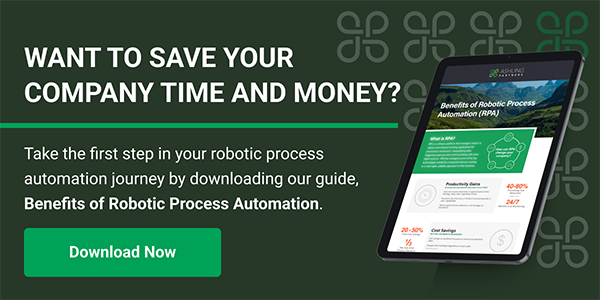Working faster and smarter is the motto of any organization. To achieve this, most are aware of the potential of automation solutions. They can be difference makers when it comes to efficiency and cost reduction. However, randomly implementing these tactics may not be serving your business in its pursuit of meeting those goals.
Automation solutions can fall flat and not hit the mark for various reasons. It could be that a particular solution isn’t right for your business. Or the implementation may have been less than seamless with lots of bumps, which can impact adoption. That’s why it’s critical to build a strategy, work with the right partner, and plan for success.
In this post, we’ll provide insights into how to get the most out of your automation solutions so your investment in them delivers the returns you expect.
What Are Automation Solutions?
Automation solutions cover a broad range of technology. In simple terms, automation means leveraging digital solutions to replace slow, manual processes with streamlined, automated ones. The technology minimizes or even eliminates the need for human input or activity.
The objective of putting automation solutions in place is to drive businesses toward greater efficiencies, reduced costs, and faster workflows. Depending on your specific goals, industry, and processes, different automation solutions fit these needs. Each plays a critical role in helping you achieve digital transformation.
Let’s look now at specific types of automation solutions.
Robotic Process Automation (RPA)
Robotic Process Automation (RPA) is technology that enables the building, deploying, and managing of software robots that emulate how humans interact with technology. These robots can mimic activities like understanding what’s on a screen, making keystrokes, navigating systems, identifying and extracting data, and more. These robots can perform these defined actions faster than humans and typically with fewer errors.
An example use case for RPA is an accounts payable team using it to match incoming invoices to purchase orders for faster processing. Letting technology handle this low-level task improves the process and lets workers focus on more high-level work.
Hyperautomation
Hyperautomation includes RPA at its core but expands upon it. What it adds to RPA is more advanced technology, including:
- AI capabilities of machine learning, natural language processing (NLP), intelligent optical character recognition (OCR), and computer vision
- Process mining, a technique to analyze and track processes to visualize them using data that can then help you streamline and accelerate them
- Analytics
The objective of hyperautomation is to automate more high-level work. Building on the RPA example above, you could enhance financial and accounting workflows more with hyperautomation. After RPA bots extract data from documents, machine learning can understand, verify, and validate it. If everything checks out, a human can give a final OK to trigger the payment.
Intelligent Automation
Intelligent automation brings together fundamental process redesign and RPA. It too uses AI, machine learning, and OCR. Intelligent automation is greater than rules-based automation, adding decision-making capabilities. Businesses apply it to an end-to-end experience, such as those in the property and casual (P&C) insurance vertical.
It can support claims processing, underwriting, policy servicing, and claims adjudication. These are time-intensive elements of which there is a high volume. Intelligent automation helps redistribute workers toward tasks that truly require human intelligence.
Document Understanding
In this type of automation, RPA, AI, and machine learning read and process documents. The process can offer many benefits, such as:
- Organizing and identifying data
- Classifying documents
- Extracting data
- Validating data for accuracy
- Exporting data
Automation Solutions Are Prevalent but Not Always Effective
You can look anywhere and see the power of automation. Every industry has adopted it in some way. In fact, according to a 2020 Future of Jobs report, 50 percent of business leaders plan to accelerate the automation of repetitive tasks, realizing this is foundational to long-term growth.
However, many still struggle with its overall effectiveness. Automation projects often falter because of a lack of planning, testing, strategizing, or anything in between.
To avoid this path, you’ll need to assess workflows with a trusted automation expert to determine priorities and expectations. If your automation journey follows a path to success, what should you expect from the solution once it is in place?
What Should Automation Solutions Be Providing Organizations?
There are three key areas in which automation can benefit an organization: saving time and increasing efficiency, improving processes holistically, and reducing costs.
Saving Time and Boosting Efficiency
Automation typically correlates to improved time savings and efficiency, goals every business is eager to hit. In fact, 74 percent of IT leaders say that employees save 11-30 percent of their time previously spent on manual tasks thanks to automation.
When your talent isn’t tied up in these tasks, they can divert attention to strategic work, which can help organizations in many ways.
For an example, let’s look at healthcare automation solutions. Healthcare is an industry saddled with lots of data, disparate systems, lack of data standardization, compliance requirements, and other complexities. Automation solutions can help solve some of these challenges. Here are some ways healthcare organizations can benefit from automation solutions:
- Linking new and legacy systems with RPA to enable easier data sharing by automating keystrokes
- Reducing the burden on clinicians for administrative tasks associated with electronic health record (EHR) applications
- Aggregating patient data within one health system to give all providers access to critical information
- Billing coding automation to reduce errors and speed up payments from insurers
Improving a Process from Top to Bottom
In addition to efficiency, intelligent automation can offer holistic improvement by rebuilding processes to address error-prone tasks. That often leads to better experiences for employees and customers.
An example is the deployment of AI-powered chatbots to engage with customers, reducing strain on agents and creating delight instead of disappointment. In this instance, automation can contribute to revenue generation because customers get answers to questions that may have been keeping them from completing a purchase.
Reducing Costs
The third key expectation you should have regarding automation solutions is that they’ll reduce costs. According to a survey by WorkMarket and KRC Research, 31 percent of business leaders agree that automation software leads to reduced labor costs. If you’re not realizing savings, then it’s time to retool your automation.
An industry that does this well is manufacturing. Automation solutions help manufacturing employees get out of the data entry realm and back to more critical work.
Greater accuracy should also be an expectation for automation. Removing the human element eliminates the errors they often create. With document understanding, you can extract data using AI, OCR, and machine learning to organize it.
As a result of all these benefits, you should also see increased employee satisfaction because tedious workflows are no longer consuming their days.
Rethinking Automation: Questions to Pose to Determine How Efficient Solutions Are
As you measure the impact of automation, you’ll want to keep these questions top of mind:
- What costs were reduced or eliminated?
- How much more efficient are processes? Can you quantify this based on the time it takes to do them?
- Are new workflows speeding up processes?
- Is automation delivering better customer experiences?
- Do employees using automation report better engagement and use of time?
- Have errors decreased?
- Can you connect ROI to automation solutions?
- Where are the gaps?
The answers to these questions should reveal the effectiveness of your automation solutions and the areas that are still a work in progress.
Get the Most Out of Business Automation Solutions
Automation solutions are critical to any company’s future. However, the application of automation isn’t one-size-fits-all. Simply having a solution doesn’t guarantee success. Applying the right automation to the right process and then measuring how it’s delivering returns will help you find the sweet spot.
Learn more about achieving this by reading our guide, Benefits of Robotic Process Automation.



